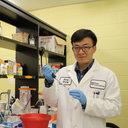[Protective effect of sesamin against myocardial injury induced by cadmium chloride in rats].
Märksõnad
Abstraktne
OBJECTIVE
To investigate the protective effect of sesamin against cadmium chloride (CdCl2)-induced cardiotoxicity in rats.
METHODS
Fifty male Wistar rats were randomly assigned to five groups: control group, CdCl2 group, and low-, middle-, and high-dose sesamin groups. The control group was given normal saline. The CdCl2 group and sesamin groups were intraperitoneally injected with CdCl2 (5 mg/kg×2 d), and the low-, middle-, and high-dose sesamin groups were given 20, 40, and 80 mg/kg sesamin, respectively. All treatments lasted for four weeks. ECG was measured by a physiological recorder, and serum myocardial enzyme levels were determined by biochemical assay. The heart was weighed, and heart tissues were used in histopathological examination and determination of malondialdehyde (MDA) level.
RESULTS
Compared with the control group, the CdCl2 group showed significantly higher levels of serum CK and CK-MB, an increased heart coefficient, significant ST-segment elevation, and higher level of MDA in myocardial tissue (P < 0.05). Histopathological analysis showed edema of myocardial tissues and cells, myocardial fibers disorder, karyopyknosis, and uneven or deep staining of nuclear chromatin. Different doses of sesamin relieved the myocardial pathological changes induced by CdCl2, and high-dose sesamin was the most effective. The middle- and high-dose sesamin groups showed significantly reduced serum CK and CK-MB levels compared with the CdCl2 group (P < 0.05). The heart coefficient of the high-dose sesamin group (0.19±0.01%) was significantly lower than that of the CdCl2 group (0.21±0.01%) (P < 0.05). Myocardial MDA levels of the three sesamin groups (42.32±4.65, 36.71±5.34, and 33.12±4.62 nmol/mg pro, respectively) were all significantly lower than that of the CdCl2 group (55.87±3.65 nmol/mg pro) (P < 0.05).
CONCLUSIONS
Sesamin can relieve myocardial injury induced by CdCl2, and one possible mechanism is the enhancement of antioxidant capacity of myocardial tissue.




